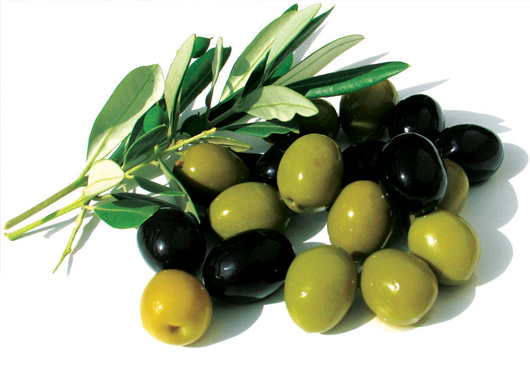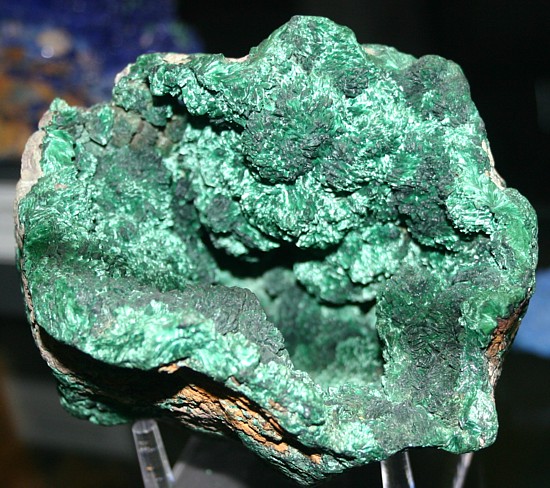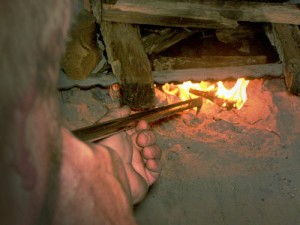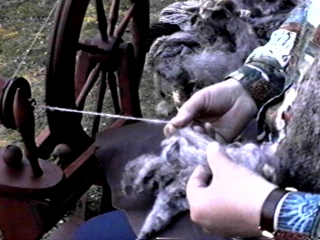*History 8 The End of the Stone Age Video Notes
Return to Main Page History 8
Contents
- 1 1. Where did the Ghassoulians live? What did they produce and trade?
- 2 Bibliography
- 3 2. How did they overcome the lack of water in their area?
- 4 3. What rock was mined to produce copper?
- 5 4. Describe and give the effects of smelting. What effect did this have on trade?
- 6 5. What happened to the Ghassoulians? What was their legacy?
- 7 6. Who were the Beaker people? What was distinctive about their graves?
- 8 7.What were they creating that was different? What was the significance of this invention?
- 9 8. What was the impact of the Beaker People on Europe?
- 10 9. What two metals were combined to make bronze? What effect of bronze on armaments?
- 11 10. What were the effects of the introduction of the horse? On Social organization?
- 12 11. When was the wheel invented? What was its effect?
- 13 12. What item flowed from Europe back to the Middle East? What bound daily life?
- 14 13. How did spinning begin and what were the implications of the new clothing?
- 15 14. How are the contents of passage tombs different from the contents of the mound graves?
- 16 15. What was found in the pools? How does this show a development of religious thought?
1. Where did the Ghassoulians live? What did they produce and trade?
6,000 years ago in the Middle East, at a thriving town of Teleilat Ghassoul on the edge of the Dead Sea, the Ghassoulians had placed themselves directly on a major trade route that linked two great emerging powers - the Sumerians on the Euphrates and the Egyptians on the Nile. The Ghassoulians were the providers of mass-produced staples, such as olives(the gold of the Middle East) and salt. Their trading culture was successful and sophisticated. Archeologists have found evidence of early irrigation. They had discovered copper with the smelters cast axe-heads and ornate ritual objects. It was a prime trade item, and the idea of trading and how to live by it (rather than farming) moved from the Middle East to Europe.

Bibliography
http://www.marcom.com.au/product_details.php?prod=5ABSFS3
2. How did they overcome the lack of water in their area?
To overcome the lack of water in their area, the Ghassoulians built irrigation channels. They built these methods of irrigation before the infamous Egyptians. [1] An irrigation channel is a passage dug into the ground to transport water to crops or to a village. [2] Some problems that might have occured to the Ghassoulians when they built their irrigation channels may include but are not limited to: inconsistent supply of water, insufficiently drained soil, and bad regional drainage. [3]
File:Http://www.globaleye.org.uk/secondary spring01/focuson/images/irrigation project.jpg
http://dox.aea1.k12.ia.us/guides/DVD01637.pdf
http://www.macmillandictionary.com/dictionary/british/irrigation-channel
http://mygeologypage.ucdavis.edu/cowen/~GEL115/115CH17oldirrigation.html

3. What rock was mined to produce copper?
Green Malachite, although first mined solely for its beautiful color, was soon used to melt down and produce copper.

~Frances Hellums
Source: "The End of the Stone Age" Video
Picture: http://nevada-outback-gems.com/copper-ores/copper_ores.htm
4. Describe and give the effects of smelting. What effect did this have on trade?
Smelting is the process of heating ore to extreme temperatures until it melts in to its metal form and can be created into something new (ie. a weapon, ornament, blade, etc.). This process uses a long narrow tube, called a blow pipe, to heat up the fire to high than normal temperature.

These new methods created an explosion in trade. People from al over wanted to get their hands on the green malachite, so that they two could create such amazing tools and decorations as those made of copper. Loads and shipments started being excavated from the mountains an sent far wand wide, foe people to use.
~Frances Hellums
Sorce: "End of the Stone Age" video
Picture: http://survivaltek.com/?p=1905
5. What happened to the Ghassoulians? What was their legacy?
6. Who were the Beaker people? What was distinctive about their graves?
The beaker people were a group of traders located in Europe. The beaker people had full sized coffins carved out of trees containing clothed bodies, bronze beakers and bronze weaponry. They are called the beaker people because of the beakers that they made, implying that they drank liquids other than water. The graves also contained bronze jewelry. The beaker people brought smelting and trade to Europe. They also invented bronze by mixing molten tin with the molten copper, resulting in a stronger material. Because of trading, they grew very wealthy, and used their wealth and their power to become the higher social class. They governed the other people located in Europe. Their weaponry was far more advanced than the stone tools used before smelting. They could attach the weapons to other things like arrow shafts or spear handles better, and due to the precision crafting, bladed weapons grew more popular. Due to their advanced military power, they got distinguished as warriors.
Information from "The End of the Stone Age" video
7.What were they creating that was different? What was the significance of this invention?
The Beaker people were the first to use fermentation to create alcoholic drinks. This was significant because it distinguished the rich from the poor. Only the rich people had the money for the sweeteners and were able to create these beverages. They quickly became used for religious ceremonies as well. They had one drinking cup that they would share and drink from it. They would hold it with two hands and pass it around from person to person. It became a large part of their lives. They were even buried with their drinking cups.

This is an image of a drinking cup that belonged to the Beaker People.
-Victoria Lima
Sources: “The End of the Stone Age” Video
Image: http://www.britannica.com/EBchecked/topic/57200/Beaker-folk
8. What was the impact of the Beaker People on Europe?
Named after their famous pottery drinking vessels, the Beaker people made a huge impact on the then Stone-age farmers in Europe. The Beaker people are widely accepted as the people who brought bronze to Europe. The Beaker People were known for their belief in individual worth, as exemplified by their individual burials instead of traditional mass, communal burials. The Beaker people brought a spirit of change to Europe, in addition to the art of smelting. The copper and eventually bronze tools developed by the Beaker people eventually gave rise to advanced warfare. Their namesake beakers were likely used in drinking rituals in which honey-based mead was consumed. The Beaker people, assimilated easily into the people previously residing in Europe, made a huge social impact by introducing copper, as the tools made from it were used in warfare in introduced classes. The ceremonies introduced to Europe made a big impact as well. Overall, the Beaker people brought about a great change in the technology, social structure, and culture of Europe. [4]
All information taken from class notes or from BBC website (see footnote 1).
-Christian Maines
9. What two metals were combined to make bronze? What effect of bronze on armaments?
The Beaker people combined copper ant tin to create bronze.
10. What were the effects of the introduction of the horse? On Social organization?
The horse was a symbol of wealth for many reasons.
The first reason was that the horse moved swiftly, allowing trade routes to be traveled in a shorter time. The faster people could travel the trade routes, the more times they could travel the trade route, and the more times they could travel on the trade route, the more items they could trade, and the richer they became. Also, the horse was a beast of burden, like a cow, but unlike a cow, it was faster and could get things done faster, ultimately resulting in more harvest or more goods to trade.
The horse, a very tall and grand beast, and the rider had to look down on the people below them, giving the appearance that the horse and the rider are king-like and elite. Riding on a horse forces someone to, literally and metaphorically, look up to you.
Lastly, a horse was very expensive to maintain. Horses eat a lot and buying all that grain and hay for them to digest costed a lot of money. Owning a horse symbolized that you had enough money to maintain and keep it alive, which was rare among the early people. [7]
After the horse was adopted into everyday life, the leaders, or the people who owned horses, were more prominent than ever, preoccupied with power. In many cultures that believe that animals are gods, the horse was revered as a god, and great respect was bestowed on the person who owned a horse. This is one way that the leaders in the social organization could organize and maintain the public. The introduction of the horse ultimately distinguished the elite, rich leaders from the common folks.[8]
11. When was the wheel invented? What was its effect?
The first wheel was invented around 5,500 yrs ago. They were simple, solid, wooden wheels. They turned with the axle, which probably made a large creaking noise. It originated in the Middle East and spread to Europe. In a muddy landscape without roads, it transformed movement and peoples' way of life. Now, large quantities of items could be transported from place to place faster and easier, making trade a bigger part of their life.

Sources: “The End of the Stone Age” Video
Wheel image: http://www.markville.ss.yrdsb.edu.on.ca/projects/classof2008/chong2/zhang/Astronomy.htm
-Christina Ru
12. What item flowed from Europe back to the Middle East? What bound daily life?
Many items were traded between the Middle East and Europe, such as cattle or the invention of the wheel(5.5 kya), but two things would become a huge trend throughout their known world. The first of these two items was amber, or the sap from fossilized trees. This substance was used in jewelry and other ornaments.

The second of these items was bronze. bronze revolutionized the world and brought it into a new era. It brought defined social classes and armies to support the upper class. Beautiful jewelry was crafted using bronze.

This beautiful piece of jewelry from Northern Europe is fashioned from bronze.
The daily life of villagers in the Ghassoulians' time was bound by sharing. Towns, villages, and little family farms shared what they grew, harvested, or herded with other people. They traded and bartered. This was a very revolutionized idea that would eventually lead to modern day finance. Bibliography:
http://skywalker.cochise.edu/wellerr/mingem/gemtl/amber/6y1-amber-red-baltic35
-Hayden Simmons
13. How did spinning begin and what were the implications of the new clothing?
The farmers in Europe were able to grow a new breed of sheep, specifically bred for its fleece. These new sheep had a fleece that was curly and dense. This was similar to today's wool. Because of this advance in breeding, they developed spinning to make use of it. As a result, clothing became warmer. Because the wool-making process was time consuming, it was only affordable for the wealthy; this led to wool clothing becoming a status symbol. After the wool was spun, it was dyed, which further made it a symbol of the elite.
-Irene Vazquez
14. How are the contents of passage tombs different from the contents of the mound graves?
Mound graves and passage tombs both utilize the idea of laying the dead body on the ground and then burying it by building a hill of dirt over the corpse, as opposed to digging a hole for a coffin and then filling it like today. There are several differences between the tombs though. In a passage tomb, your body wasn't just lain down like in a mound grave, you were put in a makeshift wooden coffin with your most personal items. These items ranged from swords a chief could have used, to drinking cups and woolen clothing. In mound graves, the bodies were buried with less personal objects. They were buried with jewelry or religious objects.
Matthew Walsh

Source: End of stone age video
15. What was found in the pools? How does this show a development of religious thought?
At the end of the Stone Age, archaeologists discovered ceremonial pools guarded by "mother figures". People made offerings to the ceremonial pools by tossing offerings into them, some were bronze. Warriors also tossed offerings into the pool, when they gave an offering, not only was it a tribute to the ceremonial pools and what they stand for, but it meant that they were seeing their spiritual world in a new way. This showed a development of religious thought because it meant that the people believed in something that they couldn't see. They had enough faith in something to give up their goods in honor of something that they had to just put all their faith into because they couldn't see it.
Image:
-Caroline W.
Text learned from "End of Stone Age" film Picture from: http://www.siloam.net/lascaux/
- ↑ http://dox.aea1.k12.ia.us/guides/DVD01637.pdf
- ↑ http://www.macmillandictionary.com/dictionary/british/irrigation-channel
- ↑ http://mygeologypage.ucdavis.edu/cowen/~GEL115/115CH17oldirrigation.html
- ↑ "Bronze Age Britain." Ancient History. BBC, 2012. Web. 24 Oct. 2012. http://www.bbc.co.uk/history/ancient/british_prehistory/bronzeageman_01.shtml>.
- ↑ Dover Museum, 2012. Web. 24 Oct. 2012. <
 >.
>.
- ↑ The West Film Project. "Crazy Horse." NetTrekker. N.p., n.d. Web. 25 Oct. 2012.
- ↑ The End of the Stone Age. Prod. Schlessinger Media. 2003. 2003. DVD.
- ↑ The Power of Myth. Prod. Athena. 2001. 2010. DVD.


